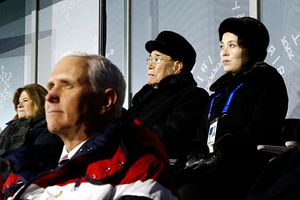The PyeongChang Olympic Games officially kicked off with the Opening Ceremony on February 9. In one the most anticipated moments, North and South Korean athletes marched together behind the white-and-blue Korean Unification Flag. The last time that occurred in an Olympic context was at the 2006 Winter Games in Turin, Italy.
The attendance of North Korean athletes, which followed a flurry of diplomacy in January and February, was just the tip of the iceberg, however. After North Korean leader Kim Jong-un unexpectedly signaled a willingness to support the Games in South Korea in his New Year’s address, the Moon Jae-in administration in Seoul moved quickly to make good on the opportunity. As a result, nearly 500 North Koreans have traveled to South Korea for the games, including top officials. Most notably, North Korea’s ceremonial head of state, Kim Yong-nam, and Kim Jong-un’s sister, Kim Yo-jong, were both in attendance at the Opening Ceremony. Kim Yong-nam is the highest-ranking North Korean official to ever visit the South, while Kim Yo-jong is the first member of the ruling family to do so.
Meanwhile, the United States was represented at PyeongChang by Vice President Mike Pence. Ahead of the Olympics, there was much speculation about whether Pence would meet with members of the North Korean delegation, potentially signaling a willingness to support a broader U.S.-North Korea dialogue.
That seemed unlikely, however, given the tone of Pence’s remarks ahead of his arrival in South Korea.
During a visit to Yokota Air Base in Japan, Pence devoted a sizable portion of his speech to condemning “the rogue regime in North Korea” for its dismal human rights record, support for international terrorism, and pursuit of nuclear weapons.
“The American people, the people of Japan, and freedom-loving people across the wider world long for the day when peace and prosperity replace Pyongyang’s belligerence and brutality,” Pence said. “[…]North Korea’s continued threats have stirred the United States of America to act, and we will continue to act with vigilance and resolve as our lodestar.”
Just before boarding Air Force Two for South Korea, Pence spoke more specifically about North Korea’s participation in the Olympics. He told reporters that he would “continue to seize every opportunity to ensure that North Korea does not use the powerful imagery and backdrop of the Olympics to paper over an appalling record of human rights and a pattern of developing weapons.”
“When the Olympics are long a distant memory,” Pence added, the United States would “continue to isolate North Korea economically and diplomatically.”
At the same press event, Pence confirmed that he had not requested a meeting with any members of the North Korean delegation. If an informal meeting did occur, he said, he would convey the message that “North Korea must end this long era of deception, provocation, of developing nuclear weapons, threatening the region and the wider world.”
It did not come as a surprise, then, that Pence did not meet with either Kim Yong-nam or Kim Yo-jong. In fact, Pence apparently cut short his attendance at a reception hosted by Moon in order to avoid interacting with the North Korean head of state. According to the Korea Herald, Pence (along with Japanese Prime Minister Shinzo Abe) arrived late, skipping a meet-and-greet that Kim Yong-nam was part of. Pence then left before a planned dinner, where he and Kim would have both been seated at the head table. Pence stayed long enough to shake hands with the other leaders present, but pointedly did not acknowledge Kim (Abe, on the other hand, reportedly shook hands with the North Korean official and brought up Pyongyang’s nuclear and missile programs in a brief chat).
However, Pence could not avoid being seated close to both Kim Yong-nam and Kim Yo-jong in the VIP box at the Opening Ceremony. Kim Yo-jong, in fact, was seated almost directly behind the U.S. vice president.
The cool U.S. attitude toward the North Korean presence at PyeongChang, contrasted with Moon’s enthusiasm, has sparked discussion of a growing divide between the allies over how to approach Pyongyang. In remarks after a meeting with Moon, Pence made no mention of the potential for North-South dialogue (unlike the South Korean president). Instead, he reiterated the U.S. commitment “to bring maximum pressure to bear on North Korea until that time comes when they finally and permanently and irreversibly abandon their nuclear and ballistic missile ambitions.”
However, Pence also said that his trip was meant to “reaffirm the strong and unbreakable bond between the people of the United States of America and the people of South Korea.”
Moon himself stressed that it was “the very strong and close coordination between [South] Korea and the United States that enabled North Korea to come out to dialogue and to participate in the PyeongChang Winter Olympic Games.”
“[A]irtight cooperation between Korea and the United States is of the utmost importance,” Moon added.

































